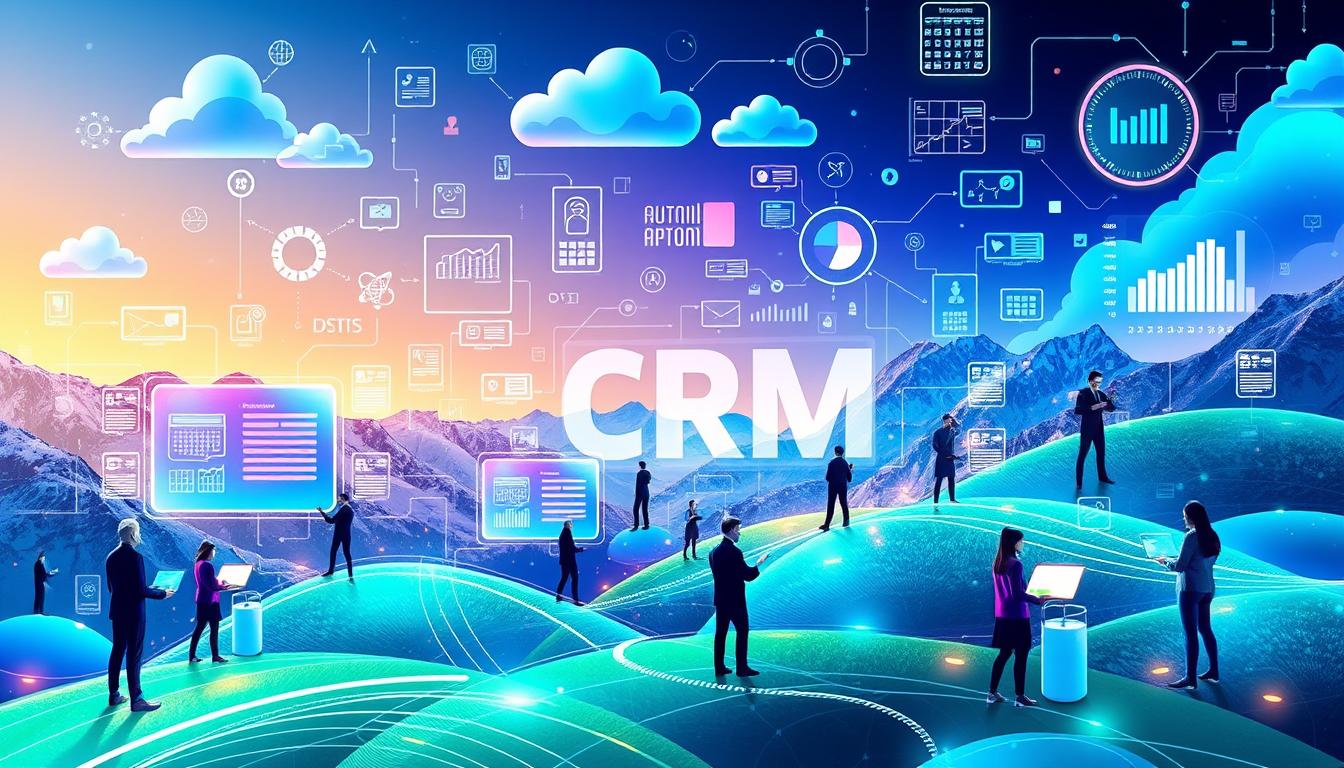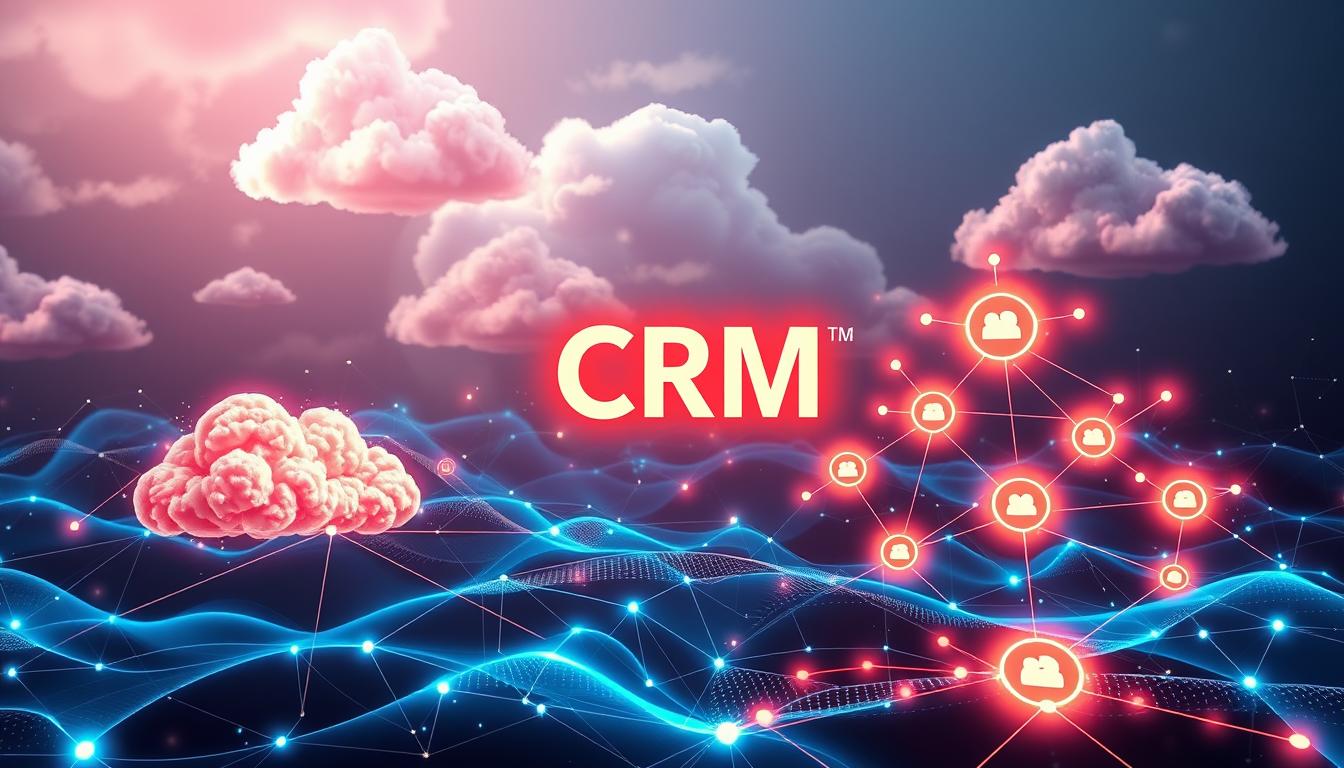The journey of Customer Relationship Management (CRM) has significantly changed how you interact with customers and boost satisfaction. As businesses grow, grasping customer behavior becomes essential. CRM software advancements play a key role here. Initially, CRM focused on maintaining strong customer ties. Now, it has evolved into a sophisticated, tech-driven tool. These systems are vital for customer-focused strategies, creating deep connections that spur growth and loyalty.
Key Takeaways
- CRM has evolved from basic methods to essential digital platforms.
- Integrating AI and machine learning in CRM enhances personalized customer experiences.
- Cloud-based solutions have revolutionized data access and collaboration.
- Real-time data streams from IoT provide deeper insights into customer behavior.
- Sustainability and eco-friendly practices are becoming integral features of CRMs.
- Mobile CRM solutions help you keep your team connected, regardless of location.
- Emphasis on data security and compliance is growing in response to stricter privacy regulations.
The Roots of Customer Relationship Management
The history of CRM shows how crucial strong customer ties are for business triumph. Companies have always aimed to enhance their client interactions, recognizing their value. From ancient bartering to modern strategies, understanding what customers want has always been key in business.
The importance of customer relationships in business history
Strong customer relationships have always been vital across all business periods. By the 1980s and 1990s, firms started automating routine tasks, making teams more productive. This shift allowed them to focus on strategic planning. CRM systems later emerged, highlighting the critical role of these relationships in driving success.
Early methods for managing customer information
Before today’s advanced tools, businesses used simple systems for managing customer interactions. Tools like the Rolodex and early databases were the starting points for organizing customer data. These methods helped companies keep track of important interaction details, paving the way for the significant CRM advancements that followed.
From Digital Rolodex to Advanced Systems
The evolution of customer relationship management has seen a significant shift from physical tools to advanced digital solutions. The advent of digital contact management solutions was crucial in this transformation. Initially, businesses used basic systems like digital Rolodexes to manage customer data. As technology advanced, the demand for more complex systems grew, leading to a major CRM software transformation.
The emergence of digital contact management solutions
In the 1970s, database systems started to appear, offering companies a structured way to manage customer information. This was a pivotal moment for CRM, as businesses looked to improve their customer interactions. By the late 1990s and early 2000s, the shift to web-based CRM solutions changed how companies accessed and used customer data. Salesforce, a pioneer in the mid-2000s, introduced cloud-based solutions, making it easier to manage without the need for extensive on-premise setups.
Transformation from basics to comprehensive platforms
Today, digital contact management solutions offer numerous benefits, including scalability and accessibility across various devices. This flexibility enables businesses to collaborate in real-time, allowing teams to work together smoothly. As CRM software continues to evolve, companies are adopting advanced analytics tools powered by artificial intelligence and machine learning. These tools refine customer insights and improve decision-making processes. With the advent of mobile CRM applications, professionals can now access vital data on the move, redefining customer relationship management in today’s fast-paced world.
The Rise of CRM Software in the 1990s
The 1990s were pivotal for the evolution of Customer Relationship Management systems. This era established the groundwork for today’s vital tools for managing customer interactions. A key event was the establishment of Siebel Systems in 1993.
The founding of Siebel Systems and its significance
Siebel Systems was born with a bold vision: to merge sales, marketing, and customer service into one. This innovation kickstarted the CRM software rise. Siebel’s unified platform showed that managing customer relationships required a holistic approach. It championed data-driven strategies, setting the stage for future industry norms.
First steps towards web-based CRMs
The 1990s saw CRM software evolve alongside the first web-based systems. These innovations enabled companies to interact with customers across various digital channels. Recognizing the importance of online accessibility, businesses saw how it could elevate customer service. Thus, web-based CRM systems became crucial for enhancing customer interactions and strategic planning.
CRM Trends in the 2000s: The Era of Cloud-Based CRM
The 2000s were pivotal for Customer Relationship Management, with businesses embracing cloud CRM solutions. Salesforce led this change, introducing technology that transformed CRM and offered significant benefits for companies aiming to improve customer interactions.
The role of Salesforce in pioneering cloud CRM solutions
Salesforce became a leader in the CRM market with its first Software as a Service (SaaS) CRM in 1999, targeting small businesses. It quickly expanded, becoming a major industry player by the early 2000s. The launch of cloud-based CRM in 2007 revolutionized how companies managed customer relationships, allowing users to access crucial information from anywhere.
Benefits of cloud CRM for businesses
Cloud CRM solutions offer significant advantages for organizations of all sizes:
- Cost-effectiveness: It reduces the need for large upfront investments in hardware and software.
- Scalability: Businesses can adapt to changing needs without significant overhead.
- Improved collaboration: Teams can share real-time updates and customer data seamlessly.
- Access from anywhere: Sales professionals can access information on-the-go, boosting productivity.
Integration of AI and machine learning in CRM systems
The 2000s saw a surge in the integration of artificial intelligence and machine learning into CRM systems. Marc Benioff, Salesforce’s CEO, played a key role by acquiring startups focused on machine learning. This move enabled businesses to leverage AI for automation, data analysis, and personalized customer engagement. The ongoing trend of incorporating AI in CRM holds promise for improving customer experiences and optimizing business operations.
Modern CRM Systems: Features and Innovations
In today’s fast-paced business environment, modern CRM systems are essential. They offer features designed to boost customer engagement and streamline operations. These tools have evolved beyond contact management. They now serve as powerful platforms that cater to the diverse needs of organizations. With CRM innovations on the rise, businesses can refine their processes and enhance their customer relationships.
Sales automation and marketing capabilities
Sales automation is a key feature of modern CRM features. It enables efficient management of sales processes. By automating repetitive tasks, it saves time and ensures accuracy. Additionally, robust marketing capabilities allow for targeted campaigns that connect with your audience. This nurturing of leads and driving of conversions is crucial for success.
Enhanced customer support functionalities
Exceptional customer support is crucial. Modern CRM systems enhance interactions with customers, making them timely and personalized. A consistent customer experience is as important as the products and services offered, with 85% of customers seeing it as such. CRM innovations help you exceed customer expectations, fostering loyal relationships.
The impact of social media integration
Social media integration is vital in modern CRM tools. It connects your CRM with social platforms, offering insights into customer preferences and behaviors. This connection enables real-time engagement with clients and dynamic strategy adjustments. As consumer expectations change, using social media integration is key to staying competitive.
CRM Technology Updates: Data-Driven Decision Making
In today’s fast-paced CRM landscape, adopting data-driven decision making is crucial for businesses aiming to stay ahead. By leveraging CRM analytics, companies can deeply understand customer behaviors. This knowledge optimizes interactions for superior results.
Analytics and business intelligence in CRM software
Advanced analytics and business intelligence have revolutionized CRM platforms. Leaders like Salesforce and Microsoft provide tools that dissect customer data for insights. These tools empower leaders to make informed decisions, refining service and marketing strategies.
Moreover, a robust analytical framework pinpoints performance issues. It enables teams to craft messaging that significantly boosts customer engagement.
Predictive analytics for forecasting customer trends
Predictive analytics marks a leap forward in CRM, enabling forecasts of future customer trends from historical data. Through complex algorithms, businesses can predict customer preferences and adjust strategies ahead of time. This foresight supports data-driven decisions and allows teams to concentrate on nurturing personal customer relationships.
With 90% of companies using CRM systems, integrating AI technology enhances efficiency. It also raises customer satisfaction and fuels growth.
The Current Landscape of CRM Software
The CRM market is expanding rapidly, expected to hit $262.74 billion by 2032. Companies are shifting focus to customer-centric strategies and data-driven approaches. Innovative CRM features are driving this growth, helping businesses align operations and gain deep customer behavior insights.

Continued evolution and innovative features
AI and machine learning have transformed CRM systems, offering advanced capabilities like natural language processing and sentiment analysis. These technologies enable personalized customer interactions, significantly improving business insights. Leading companies, such as Salesforce, now provide specialized platforms and social CRMs for various industries. This customization helps businesses utilize social media insights effectively.
The increasing role of automation in CRM systems
Automation is vital in CRM systems, boosting efficiency and reducing repetitive tasks. Automating processes like lead scoring and assignment allows teams to focus on strategic tasks. The trend towards omnichannel CRM ensures a holistic view of the customer journey by integrating data from various sources. However, data security and privacy remain top concerns due to sophisticated cyber threats.
Empowering employees with better user experiences is crucial for CRM solution effectiveness. Features like low-code tools and user-friendly mobile apps are boosting productivity in customer-facing teams. As companies adopt these innovations, we can expect to see better customer experiences and engagement.
For insights into how these trends can benefit your business, check out this resource.
Future of CRM Systems: What’s Next?
The future of CRM systems is set to be both thrilling and transformative. With the swift advancement of AI advancements and the emergence of new tools, businesses will witness significant enhancements in managing and optimizing customer relationships.
Predictions regarding AI and machine learning advancements
Experts foresee a surge in the adoption of machine learning and AI within future CRM systems. By 2024, Gartner predicts that half of CRM implementations will incorporate these technologies. This trend will lead to better data analytics, automated workflows, and more personalized customer interactions.
Potential integration of emerging technologies like AR and VR
Emerging technologies like augmented reality (AR) and virtual reality (VR) could revolutionize customer engagement. By integrating AR and VR into CRM systems, businesses can create immersive experiences. Customers can interact with products in real-time, leading to more personalized offerings. This is achieved by leveraging real-time data to shape customer decisions.

Conclusion
The CRM evolution marks a significant shift from basic tools to advanced platforms. These platforms empower businesses to build stronger customer relationships. CRM technology has become vital, with studies showing a potential 300% increase in conversion rates and a 74% improvement in customer relationships. It’s now a key part of modern business strategies.
Understanding the summary of CRM trends helps businesses adapt to the fast-changing market. The CRM market is expected to hit $82 billion by 2025, with a 12.6% annual growth rate. Integrating these systems can lead to big business benefits, like a 27% increase in customer retention and a 23% cut in lead costs.
Looking ahead, embracing CRM technology will help your business improve customer experiences, enhance sales forecasting, and drive growth. With 91% of businesses with over 11 employees using CRM systems, now is the ideal time to invest. This move will put you in a strong position for success.
FAQ
What are the current CRM trends that businesses should be aware of?
How has CRM software evolved in recent years?
What role does cloud-based CRM play in modern businesses?
How does machine learning enhance CRM software?
What are the benefits of using predictive analytics in CRM?
What innovations should we expect in the future of CRM systems?
How does data-driven decision-making influence CRM strategies?
Why is customer relationship management important for business growth?
Source Links
- Navigating the Future of Customer Engagement: 10 CRM Trends for 2024 – https://www.linkedin.com/pulse/navigating-future-customer-engagement-10-crm-trends-2024-4dpyc
- Top 10 Trends In Customer Relationship Management System – https://www.crmxchange.com/column/10trendsincrm/knowmaxmay2023.asp
- The CRM Software Trends That Will Shape Customer Relationships in 2024 and Beyond – TekRevol – https://www.tekrevol.com/blogs/crm-software-trends-that-will-shape-customer-relationships/
- The Evolution of Customer Relationship Management – https://www.vtiger.com/crm/evolution-of-crm/
- A brief history of CRM: How customer relationship management became one of the most important business software – https://www.techradar.com/pro/a-brief-history-of-crm-how-customer-relationship-management-became-one-of-the-most-important-business-software
- The Evolution of CRM: From Rolodex to Cloud-Based Solutions – https://medium.com/@shreesagarwani/the-evolution-of-crm-from-rolodex-to-cloud-based-solutions-460c6dac32b3
- The Evolution of CRM – https://www.apexhours.com/the-evolution-of-crm/
- The Evolution of CRM: From Rolodexes to Data-Driven Solutions – https://www.linkedin.com/pulse/evolution-crm-from-rolodexes-data-driven-solutions-info-techoon
- The Complete History of CRM – https://www.salesforce.com/ap/hub/crm/the-complete-crm-history/
- Evolution of CRM Industry Through The Ages – https://cta9.com/blog/evolution-of-crm-industry
- The History of CRM Systems 1980 – To Current Day – https://redresscompliance.com/the-history-of-crm-systems-1980-to-current-day/
- CRM Then and Now. How It Has Changed – OMI – https://www.omi.co/crm-configuration/crm-then-and-now-how-it-has-changed/
- CRM Adoption Patterns and Trends in Recent Years – https://salestechstar.com/staff-writers/crm-adoption-patterns-and-workflow-trends-takeaways/
- 23 Innovative CRM Trends to Pay Attention to in 2023 – https://blog.hubspot.com/sales/latest-crm-trends
- 10 Significant CRM Trends to Watch For in 2024 and Beyond – https://www.dynamicssquare.com/blog/crm-trends/
- Council Post: How AI Can Maximize Your CRM: The Future Of Customer Relationship Management – https://www.forbes.com/councils/forbesbusinesscouncil/2024/07/11/how-ai-can-maximize-your-crm-the-future-of-customer-relationship-management/
- 9 CRM trends for 2024 – https://www.cio.com/article/1255983/customer-relationship-management-crm-trends.html
- The Biggest CRM Trends to Watch in 2024 and Beyond – https://www.cxtoday.com/crm/the-biggest-crm-trends-to-watch-in-2024-and-beyond/
- CRM Trends for 2024 and beyond – https://www.insightly.com/blog/crm-trends/
- The Future of CRM: Where Is CRM Headed? – https://www.salesforce.com/crm/what-is-crm/future/
- CRM Trends 2024: the Future of Customer Relationship Solutions – https://solutionsmetrix.com/article/top-crm-trends-2024/
- The Future of CRM | CRM Future – https://www.pipedrive.com/en/blog/the-future-of-crm
- The CRM trends that defined 2023 and will shape 2024 – https://capsulecrm.com/blog/crm-trends-2024/
- 15 CRM Statistics You Need to Know in 2024 – https://pipelinecrm.com/blog/crm-statistics/


